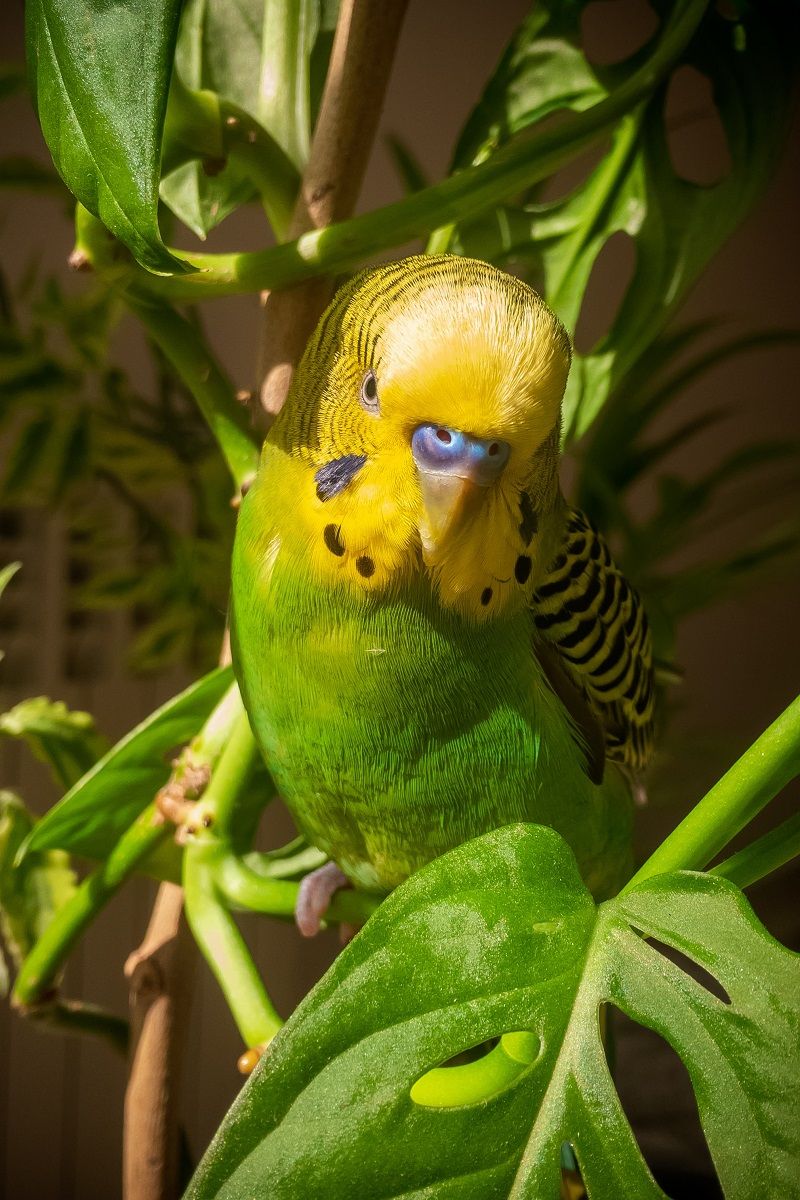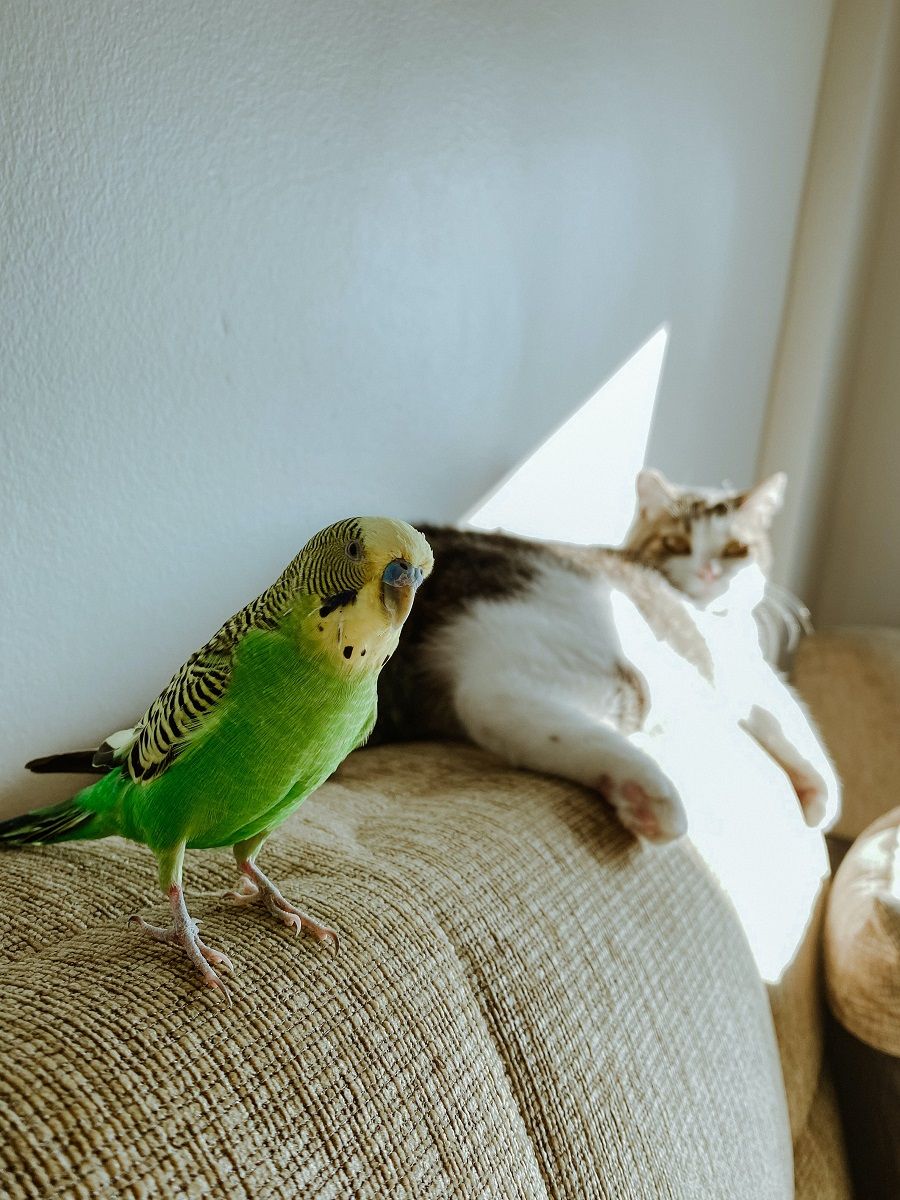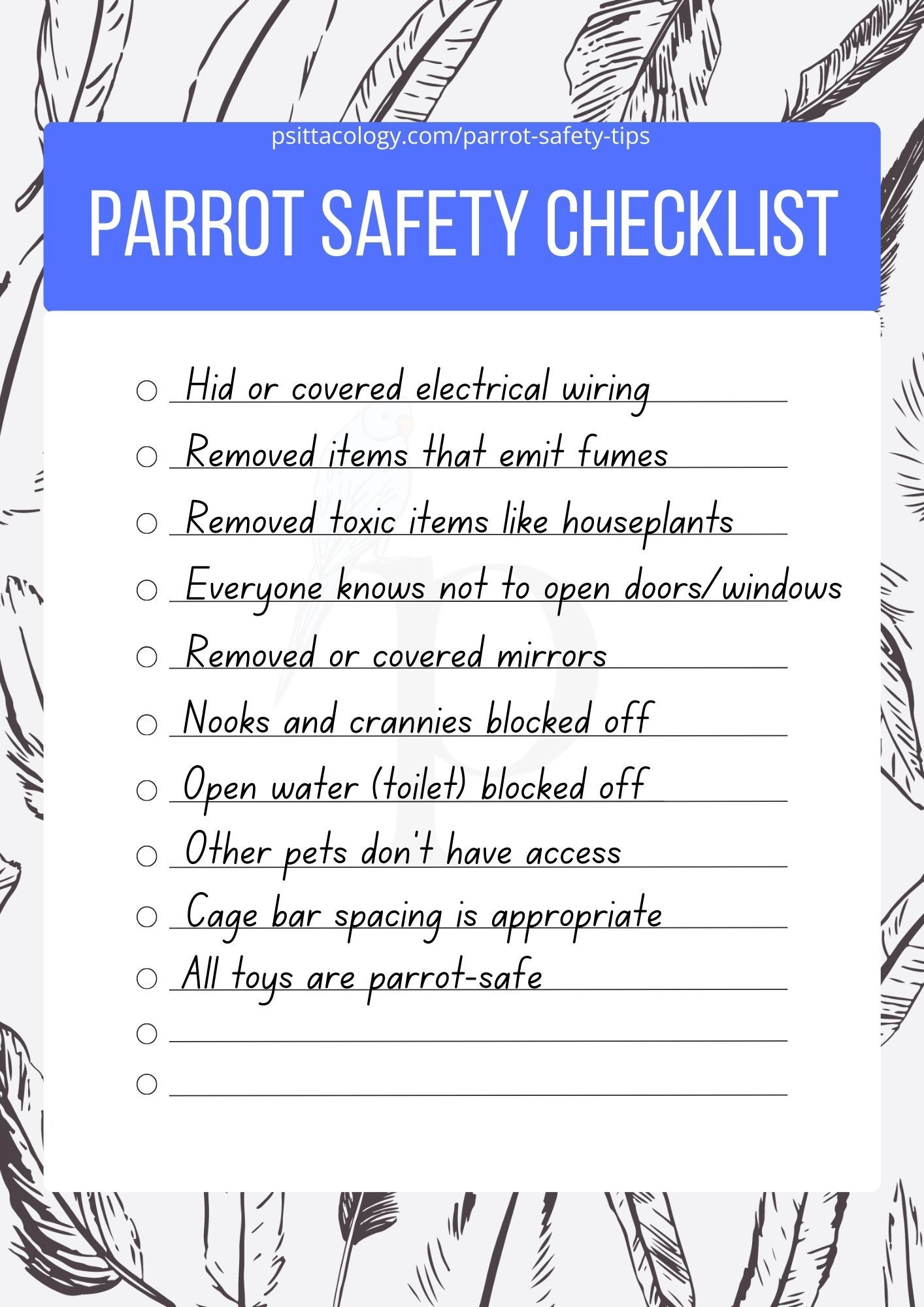Thinking of adding a parrot to your family? Between finding a suitable cage, stocking up on parrot toys, and getting to know your new bird, you’ll be plenty busy. Still, don’t forget to also take a moment to consider safety!
Our feathered friends are incredibly smart, but their brainy nature can unfortunately easily get them in trouble. They’re highly curious, love exploring, and always need to be involved in everything—but unfortunately, they have no idea how to safely navigate a human home.
It’s our job as parrot owners to ensure any space our pets have access to is fully “parrot-proofed”. That’s why below, you’ll find a checklist of 8 bird safety tips to implement before you head out to pick up your new family member.
You can find a handy printable parrot safety checklist at the bottom of this post.
Tip: Make sure your entire family is aware of these bird safety tips. Everyone should be on the same page! Your parrot’s safety should always be in the back of your mind as you move around your home. You should know basic parrot emergency care and have the number for an avian vet on hand.
1. Electrical cords & outlets
Any parrot parent knows it: our birds love to chew. It’s a natural behavior that keeps their beak in good condition. In the wild, they do it to keep their nest (located in a hollow tree) in good condition.
In our homes, anything can potentially be gnawed. The effect can range from annoying when your parrot goes for your picture frames, alarming when it starts to peel the paint off your walls, and downright dangerous when it decides to go for electrical cords or outlets.
You should take care to hide or protect (with PVC pipe, for example) any cables in rooms your parrot has access to, especially if you’ve seen it show interest in them. They can survive getting zapped, but it’s quite traumatic.
2. Fumes & air quality
This one’s well known with long-time parrot keepers, but can surprise first-time owners: parrots have extremely sensitive lungs. You can’t use any scented products around them.
Additionally, smoke and fumes can also kill our birds. Remember the canary in the mine? Cigarette smoke, burned food, overheated non-stick pans and even low air quality from nearby forest fires can make them violently ill.
As a rule of thumb, anything that comes from a spray can or that burns (due to the soot) is a no-no around your feathered friend. Here’s a non-exhaustive list:
- Sprays: perfume, deodorant, hairspray, bug spray, air freshener (including plug-in)
- Burning: any type of candle, wood fire, incense, cigarettes. This one’s extra important, because it comes with the added danger of burns.
- Fumes: non-stick cookware, cleaning products, nail polish remover, self-cleaning oven, fresh paint
For obvious reasons, you should always have a carbon monoxide detector and a smoke detector installed. Safer for your bird, and for you!
3. Accidental ingestion
If it’s out there, it can (and very probably will) be nibbled on or even consumed. Parrots can’t help themselves! Their beak is their way to interact with their world. Any room your bird has access to should be free of items that can be dangerous when ingested.
It’s okay to have plants around your bird, as there are many parrot-safe houseplants, but it’s important to remove any that are toxic.
Other items you should absolutely keep away from your bird include but are not limited to pills and medication, marihuana products, alcohol, cosmetics, toxic foods such as chocolate or avocado, items containing heavy metals like zinc, and anything else you can think of that a loose, curious parrot may be inclined to nibble on.

4. Doors, windows & mirrors
We all know you shouldn’t leave doors and windows open around your bird, but it’s just so easy to mess up. You’re in a rush, or maybe visitors didn’t get the memo… once your parrot manages to escape, it can be a huge challenge getting it back.
Because of this, I always recommend trying to add extra layers of safety. Add mosquito netting to windows in the parrot room. Stick notes to doors and windows if you have guests over. Make it a habit to check whether your parrot is in its cage before opening anything. It makes all the difference!
I also recommend covering any mirrors and other reflective surfaces. I personally thought my cockatiel was an experienced enough flier to avoid them—until one day I found a perfect, cockatiel-shaped impression on my hallway mirror. I was just lucky he wasn’t hurt.
Tip: Make it a habit to keep even interior doors closed. This helps prevent your parrot from accessing spaces it shouldn’t. Additionally, because they like sitting on top of doors, it also prevents injuries like crushed toes or lost tail feathers when someone accidentally closes the door.
5. Cage safety
Yes, these bird safety tips extend to your parrot’s very own cage. First off, when choosing a cage, consider the bar spacing. The enclosure should be as large as possible, but the bars should never be wide enough for your bird to be able to fit its head through.
Once the cage is installed, it should be subject to regular revision. If you see any rust, it should be replaced. Also check for damage caused by your bird itself, because large parrots in particular can do a number on flimsy cages!
Lastly, toys should be chosen with care and checked regularly. Research shows that some are still made with unsafe materials like zinc, or designed in such a way that they can trap a foot or beak:
Zinc toxicity occurs when zinc-containing items are ingested. Common sources of avian zinc toxicity include the coating on galvanized wire cages, galvanized toys, food and water dishes, and hardware (…).
During the writing of this article, toys sold at a bird fair, marketed as bird-safe toys, were responsible for the death of one sun conure and severe illness of another in the authors’ practice.
Teresa L. Lightfoot, DVM, DABVP–Avian*, Julie M. Yeager, DVM (2008)
Toys that are overly damaged from playing should be removed to prevent them from becoming dangerous. You can repurpose any parts that are unaffected.

6. Furniture
Again, parrots have a compulsive need to explore everything. When they’re broody or hormonal, they’ll also feel a strong desire to find small, enclosed spaces that resemble their hollow tree nests.
In the home, this can be dangerous. We don’t want our birds to get stuck somewhere, or worse, be crushed! You should block off any nooks, crannies, drawers, spaces behind furniture, and similar.
7. Water
Does your parrot like to hang out in the bathroom with you while you get ready? That’s fine, but don’t leave it unattended! It’s horrible to think about, but it’s unfortunately not uncommon for parrots to drown in uncovered toilets.
The same goes for other sources of open water. If you own an aquarium, it should have a hood. Large water-filled vases or jugs should not be accessible, nor should filled bathtubs, sinks, or buckets.
8. Other pets
This one’s unfortunately so difficult to drill into parrot owners, and I still see videos of folks letting their parrot interact with other pets all the time. I completely understand that dogs in particular can be very well-behaved, but it’s still just not safe.
Even if you think your dog, cat, ferret, rabbit, etc. is well-trained and will leave your parrot alone, consider that they can’t keep your bird’s safety in mind.
Even an accidental scratch can kill a fragile parrot due to infection. Or what if your bird gets crushed? Additionally, a parrot suddenly fluttering off can trigger the prey instinct in even the best-behaved of animals.

Miscellaneous bird safety tips
Here are some safety tips that don’t really belong in any other category:
- A surprisingly common killer of domestic parrots is the ubiquitous ceiling fan. Turn it off whenever your bird is around.
- Taking a nap with your parrot around is fun, but they should never be around you while you sleep due to the risk of crushing.
- Keep an eye on kids or guests when they’re interacting with your bird. Not just for your parrot’s safety, but also because not everyone knows what triggers a bite!
If you have any more questions about these bird safety tips or if you’d like to share your own experiences with and ideas for parrot-proofing a space, don’t hesitate to leave a comment below!

